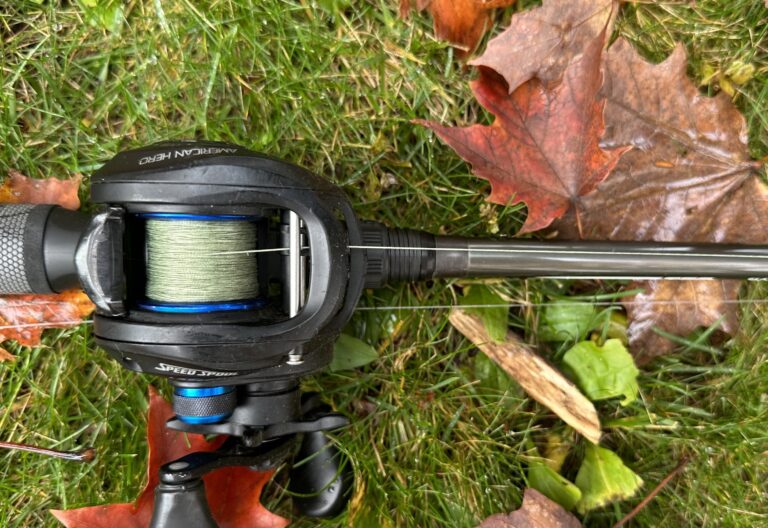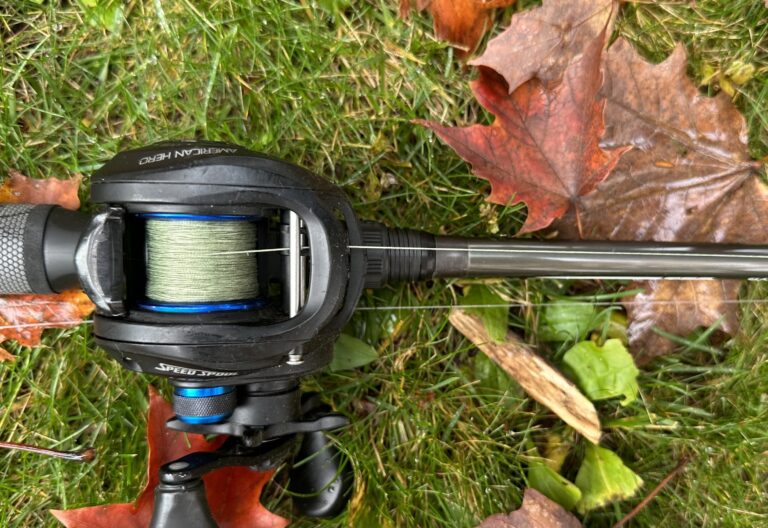To maintain baitcasting reels, regular cleaning and lubrication should be performed. Regular maintenance tasks for baitcasting reels include thorough cleaning of the reel components, lubricating the gears and bearings, checking for any damages or wear, and adjusting the brake system if necessary.
Keeping the reels clean and properly lubricated not only extends their lifespan but also ensures smooth and efficient operation during fishing. Neglecting maintenance tasks can lead to decreased performance, increased friction, and potential damage to the reel. By following a regular maintenance routine, anglers can maximize the performance and durability of their baitcasting reels, enabling them to enjoy more successful fishing trips.

Credit: www.amazon.com
Why Baitcasting Reel Maintenance Is Important
The Role Of Maintenance In The Performance Of A Baitcasting Reel
Maintaining your baitcasting reel is crucial if you want it to perform at its best. Regular maintenance not only ensures smooth casting and reeling but also extends the lifespan of the reel. By minimizing the risk of malfunctions and damage, you can enjoy a more efficient and trouble-free fishing experience.
Let’s delve into the key points of why baitcasting reel maintenance is important:
Ensuring Smooth Casting And Reeling
- Regular cleaning and lubrication of the reel’s components help to maintain smooth and effortless casting and reeling action.
- Cleaning removes dirt, debris, and saltwater residue that can cause friction and hinder the reel’s performance.
- Lubrication of the gears, bearings, and other moving parts reduces friction and enhances the reel’s overall efficiency.
- Properly lubricated ball bearings enable smoother line retrieval, reducing the chances of line tangling or breaking.
Extending The Lifespan Of The Reel
- Routine maintenance significantly extends the lifespan of your baitcasting reel.
- Cleaning and lubricating the reel prevent corrosion and rust, which can deteriorate the reel’s internal and external components.
- Regular inspections help identify any wear or damage early on, allowing for timely repairs or replacements, thus preventing additional damage.
- By taking care of your reel, you avoid costly repairs or having to replace the entire reel prematurely.
Minimizing The Risk Of Malfunctions And Damage
- Neglected reels are prone to malfunctions and damage, leading to frustrating fishing experiences.
- Regular maintenance, including checking for loose screws, damaged parts, and signs of wear, helps identify potential issues before they become major problems.
- Cleaning and lubrication reduce the chances of mechanical failures, such as sticking or grinding gears.
- Properly maintained baitcasting reels are less likely to experience handle slippage, drag system issues, or backlash during casting.
In Conclusion
Regular maintenance of your baitcasting reel is vital to ensure its optimal performance on the water. By cleaning, lubricating, and inspecting your reel, you can enjoy smooth casting and reeling, extend its lifespan, and minimize the risk of malfunctions and damage.
Investing time in maintenance now will save you from frustrating fishing experiences and costly repairs in the long run. Take care of your baitcasting reel, and it will reward you with many successful fishing trips to come.
Essential Tools For Baitcasting Reel Maintenance
Baitcasting reels are essential tools for serious anglers who want precise control over their fishing line. However, like any piece of equipment, baitcasting reels require regular maintenance to ensure optimal performance and longevity. To perform proper maintenance on your baitcasting reel, you’ll need a few essential tools.
Below are the key tools you should have in your arsenal for baitcasting reel maintenance:
Tool 1 – Cleaning Brushes And Lubricants For Regular Maintenance
- Cleaning brushes: These brushes are specifically designed to remove dirt, debris, and old lubricant from the various parts of your baitcasting reel. They come in different sizes and shapes to tackle hard-to-reach areas.
- Lubricants: To keep your reel running smoothly, you’ll need appropriate lubricants. Use reel oil to lubricate small moving parts, such as bearings and gears, for optimal performance. Furthermore, reel grease should be applied to key components, like the drag system and spool, to prevent friction and ensure smooth operation.
Tool 2 – Screwdriver Set For Disassembling The Reel
- Screwdriver set: Disassembling your baitcasting reel is often necessary to fully clean and maintain it. A quality screwdriver set with various head sizes will allow you to remove screws and access each part of your reel with ease. Make sure to choose a set that is compatible with the screws used in your specific reel model.
Tool 3 – Microfiber Cloth For Cleaning Delicate Parts
- Microfiber cloth: Delicate parts of your baitcasting reel, such as the spool and handle, require gentle cleaning to avoid damaging them. A soft microfiber cloth is perfect for removing dust, fingerprints, and other particles without scratching or leaving lint behind. Regularly wipe down these parts to keep them in pristine condition.
Tool 4 – Reel Grease For Lubricating Key Components
- Reel grease: As mentioned earlier, reel grease is essential for lubricating key components of your baitcasting reel. It provides long-lasting protection against wear and tear caused by friction. When applying reel grease, focus on areas that experience the most stress, such as the drag system and gears.
Tool 5 – Reel Oil For Smooth Operation
- Reel oil: To ensure smooth operation and prevent corrosion, reel oil is a must-have tool for baitcasting reel maintenance. Apply a drop of oil to bearings, gears, and other moving parts to reduce friction and keep them operating flawlessly. Regularly oiling your reel will enhance its overall performance and extend its lifespan.
With these essential tools in your toolkit, you’ll be well-equipped to perform regular maintenance tasks on your baitcasting reel. Remember, proper maintenance not only prolongs the lifespan of your reel but also enhances its performance, guaranteeing countless successful fishing trips in the future.
Happy angling!
Step-By-Step Guide To Proper Baitcasting Reel Maintenance
Step 1: Preparing The Work Area And Gathering The Necessary Tools
Before you begin the process of maintaining your baitcasting reel, it’s important to gather all the tools you’ll need. Here are the key points to keep in mind:
- Clear a clean, well-lit workspace where you can comfortably work on your reel.
- Make sure you have the following tools on hand:
- Screwdriver set with various sizes and types
- Reel grease and oil
- Cleaning brushes or toothbrushes
- Cotton swabs or q-tips
- Soft cloth or paper towels
- Reel cleaner or mild detergent
- Rubber gloves for protection from chemicals
Step 2: Disassembling The Baitcasting Reel
The first step in the baitcasting reel maintenance process is disassembling it. Here’s how you can do it effectively:
Substep 2.1: Removing The Handle And Side Plate
- Locate the screws holding the handle and side plate in place and use the appropriate screwdriver to remove them.
- Carefully remove the handle and side plate, making sure not to lose any small components that might come off.
Substep 2.2: Taking Apart The Drag System
- Locate the drag system, usually located under the side plate.
- Remove any screws or clips holding the drag system in place and carefully take it apart, paying attention to the order of the components.
Step 3: Cleaning The Reel Components
Once the reel is disassembled, it’s time to clean the components thoroughly. Here’s what you should focus on:
Substep 3.1: Removing Dirt, Debris, And Old Lubricants
- Use a soft cloth or paper towel to wipe away any visible dirt, debris, or old lubricants from the components.
- For hard-to-reach areas, such as the gears, use a toothbrush or a small cleaning brush to gently scrub away any residue.
Substep 3.2: Inspecting And Cleaning The Bearings
- Inspect each bearing for any signs of corrosion or damage.
- Use a cotton swab or q-tip dipped in reel cleaner or mild detergent to clean the bearings, gently wiping away any dirt or grime.
Step 4: Lubricating The Reel
Proper lubrication is crucial for the smooth operation of a baitcasting reel. Here’s what you need to do:
Substep 4.1: Applying Reel Grease To Key Components
- Apply a small amount of reel grease to the gears, pinion, and other key components that require lubrication.
- Make sure to distribute the grease evenly and avoid applying too much.
Substep 4.2: Using Reel Oil To Lubricate Smaller Moving Parts
- Apply a few drops of reel oil to the bearings, bushings, and other smaller moving parts.
- Be careful not to over-lubricate, as excess oil can attract dirt and cause issues.
Step 5: Reassembling The Baitcasting Reel
Once the components are clean and lubricated, it’s time to put them back together. Follow these steps:
Substep 5.1: Putting The Drag System Back Together
- Reassemble the drag system in the precise order that you disassembled it, ensuring each component is aligned correctly.
- Use the appropriate screws or clips to secure the drag system in place.
Substep 5.2: Attaching The Handle And Side Plate
- Align the handle and side plate with the reel body.
- Insert and tighten the screws carefully, making sure not to overtighten them.
Step 6: Performing A Final Check And Test
Before you finish, it’s essential to perform a final check and test the reel’s performance. Here’s what you should do:
Substep 6.1: Ensuring Everything Is Properly Aligned And Secured
- Double-check that all the components are securely in place and properly aligned.
- Ensure that all screws are tightened, but be cautious not to overtighten them and risk damage.
Substep 6.2: Testing The Reel’S Performance
- Attach the reel to a fishing rod and spool it with the appropriate line.
- Operate the reel to test its smoothness, drag function, and overall performance.
Remember, proper maintenance is crucial for the longevity and performance of your baitcasting reel. By following this step-by-step guide, you can ensure your reel stays in top condition and ready for your next fishing adventure.
Conclusion
Regular maintenance is essential for keeping your baitcasting reels in optimal condition. By following these recommended upkeep tasks, you can extend the lifespan of your reels and ensure smooth and efficient fishing experiences. Start by rinsing your reel with freshwater after each use to remove any salt or debris that may have accumulated.
Oil and grease the necessary parts to prevent rust and maintain proper functioning. Regularly check and replace the fishing line if it shows signs of wear and tear. Keep an eye on the drag system and clean or replace as needed.
Finally, store your reels in a cool and dry environment to prevent damage. By implementing these maintenance tasks, your baitcasting reels will continue to perform at their best, providing you with enjoyable and successful fishing adventures for years to come.






